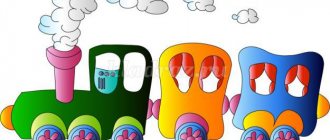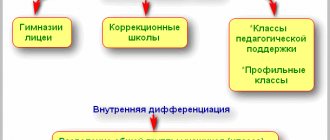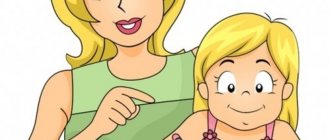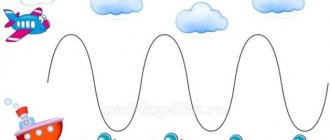On the topic: methodological developments, presentations and notes
Class: a group of 2nd grade students with a conclusion “impaired writing and reading, .
The lesson material is aimed at differentiating the sounds [z] - [s] for students and consolidating the pronunciation of the sound [t] in independent speech. The second part of the lesson is the development of speech hearing (working with text.
This material can be used in working with children with hearing impairment.
A summary of a lesson using health-saving technologies is presented.
Lesson summary with a full set of cut cards.
Lesson summary with a full set of cut cards.
Lesson summary with a full set of cut cards.
Summary of frontal speech therapy lesson “Differentiation of sounds [G]-[K]”
Tatyana Alferova
Summary of frontal speech therapy lesson “Differentiation of sounds [G]-[K]”
Summary of frontal speech therapy session
«Differentiation of sounds [G]-[K]»
Educational: teach to distinguish sounds [G] – [K] ; highlight the sounds [G] - [K] among other sounds , syllables , words; clarify the acoustic-articulatory characteristics of these sounds , conduct a comparative analysis; learn to determine the position of a sound in a word ; learn to differentiate the letters G - K in writing.
Correctional: develop phonemic hearing, phonemic perception.
Developmental: develop skills in the operations of phonemic analysis and synthesis; develop visual perception, thinking, auditory and visual memory.
Equipment: subject pictures, symbol cards, cards with a written task for each child.
Summary of a speech therapy lesson on differentiating G–K sounds in syllables and words
Sections: Speech therapy
Purpose: to teach students to distinguish by ear and in writing the consonants G-K in syllables, words and sentences.
Tasks:
- development of phonemic hearing;
- strengthening the differentiation of the letters G-K in writing;
- development of sound analysis and synthesis skills;
- development of visual-spatial orientation;
- development of attention, memory, thinking;
- expansion of vocabulary.
Equipment: syllable table, task cards, ball, workbooks.
1. Organizational moment
– Listen to the poem and count how many times the sound [G] occurs in it:
Goose bought himself an accordion, but it was a little holey. The harmonica sang well and hissed like a goose. G. Vieru – 4 times.
– Now listen to another poem and count how many times the sound [K] occurs in it:
Gurgling in drops, the icicle cried: “I wanted to sit higher, I wanted to climb onto the roof.” And I stepped on the cornice - And I’m afraid to fall down! Cap! Cap! Cap!
2. Clarification of the connection between letters and sounds
– Tell me, is the sound [G] a consonant or a vowel? Why? - Voiced or voiceless? Why? – Is the sound [K] a consonant or a vowel? Why? - Voiced or voiceless? Why? – What do the sounds [G] – [K] have in common and how do they differ?
3. Syllable table
– What syllable is in the right-left corner? – What syllable is in the upper left corner? - Read the first column of syllables. - Read the last column of syllables.
4. Listen to the syllables, write down only the first letter of each syllable.
- Gee, gu, ka, ki, go, ke, ge, kya; kra, cro, gra, kra, gro, gra, gro, gree, cree, gri.
5. Chain of syllables
“Listen to the rows of syllables, repeat them in the same sequence,” answers the one with the ball in his hands.
Ga - ka - ga Ku - gu - ku Ka - ga - ga - ka Go - ko - go Ko - go - ko Ku - gu - ku - gu Ge - ke - ge Ke - ge - ke Ko - go - ke - ge Ka - ga - ka Gu - ku - gu Gy - ky - ky - gy
6. Select and write down three words that begin with these syllables.
(Dove, slide, year, drop, stone, frame, anthem, weight, plaster, whale, brush, bale, harbor, gas, jackdaw, horse, cobra, room)
7. Physical exercise
The rook was swinging in a hammock (leaning to the side). Geese - in the waves on the river (tilts back and forth). Pigeons flew past (shaking hands). And they sat down on a branch (squat). The branch sways (swaying with hands). It's working out well.
8. Graphic dictation
Write down only the letters “G” and “K” and next to them indicate their place in the word with a number. For example: “Rainbow” – we write G – 5.
Words: shop, cabin, mountain, whale, vegetable garden, bush, pharmacy, giant, tie, baby.
9. Take the cards. Read and write the sentence.
– POSSLAMYSHKANARK MARKET. – GRISHA WANTED TO PETROL THE GOSPS – KATYA PICKED MUSHROOMS AND YEARS
Underline the letters "G" and "K".
10. Summary of the lesson
– What sounds were we talking about? – What tasks did you like? – What letters did we remember today? – Think of each word with a “G” or “K” sound.
Bibliography:
- Barsukova L.A. Speech therapy for teachers, psychologists, parents. – Rostov n/a: Phoenix, 2010.
- Efimenkova L.N. Correction of oral and written speech of primary school students: a manual for speech therapists. – M.: Vlados, 2004.
- Krutetskaya V.A. 90 effective exercises to correct dysgraphia. – St. Petersburg: Litera Publishing House, 2012.
- Pozhilenko E.A. The magical world of sounds and words (a manual for speech therapists). – M.: Vlados, 2001.
Inclusive lesson “Differentiation of sounds [k] - [k'], [g] - [g']” for second grade students
Inclusive education is based on an ideology that excludes any discrimination against children, ensures equal treatment of all people, and creates special conditions for children with special educational needs.
Inclusive education is the process of development of general education, which implies the accessibility of education for all, in terms of adaptation to the different needs of all children, which ensures access to education for children with special needs. Inclusive education seeks to develop a child-centred methodology that recognizes that all children are individuals with different learning needs. Inclusive education tries to develop an approach to teaching and learning that is more flexible to meet different learning needs.
Children with disabilities are children whose health condition prevents them from mastering the educational program. Inclusive practice in education involves improving the quality of life of a special child and his family, without worsening, at the same time, the quality of life of other participants in the educational process, and creating the necessary conditions for success in social adaptation and education by all children without exception, regardless of their individual characteristics . Receiving an education for children with disabilities and disabled children is one of the main and essential conditions for their successful socialization, ensuring their full participation in the life of society, and effective self-realization in various types of professional and social activities.
Currently, children with musculoskeletal disorders are increasingly being integrated into the general educational environment. Students with NODD experience special educational needs due to deficiencies in their physical development, in accordance with the individual capabilities of each child, the structure of disorder and the degree of severity. In this regard, there is a need to create special educational conditions for children with special needs, which determine the effectiveness of the educational process and the child’s social adaptation in full accordance with his characteristics and educational capabilities. One of such conditions for preschoolers with NODA who have disorders in the development of oral speech is individual speech therapy support . It should become part of the individual educational route of a child with disabilities .
Joint education, interaction and development of children with disabilities with healthy children allows them to feel confident on an equal basis with healthy people, to develop the necessary knowledge, skills and abilities. Thanks to this interaction, healthy children develop tolerance, kindness, and responsiveness towards “special” children [1].
The problem of studying and correcting specific disorders of written speech (dysgraphia and dyslexia) in children is currently one of the most pressing tasks of speech therapy. Every year, the number of children with various types of dysgraphia in primary schools increases.
The main task of a speech therapist at school is to promptly identify and prevent violations of writing and reading, as well as promptly eliminate specific errors in order to prevent their transition to further education.
Joint education, interaction and development of children with disabilities with healthy children allows them to feel confident on an equal basis with healthy people, to develop the necessary knowledge, skills and abilities. Thanks to this interaction, healthy children develop tolerance, kindness, and responsiveness towards “special” children [1].
Let's consider a technological map of a lesson for second-grade students, aimed at preventing the formation of dysgraphia in children.
Technological map " Differentiation of sounds [k] - [k'], [g] - [g'] "
Class : 2 (10 people, 1 child with a mild degree of NODA).
Module: Prevention of dysgraphia.
Topic of the training session : “Differentiation of sounds [k] - [k'], [g] - [g'].”
Duration of training session : 30 min.
Type of training session : Reinforcement of the material learned.
Goal : To differentiate the sounds [k] - [k'], [g] - [g'] in oral and written speech.
Lesson objectives:
1. Educational:
- consolidate knowledge about sounds, letters [k] - [k'], [g] - [g'], learn to give a full description of sounds.
- consolidate the correct articulation and skills of correct pronunciation of sounds [k] - [k'], [g] - [g'] in syllables, words, sentences.
- consolidate knowledge of spelling norms.
2. Developmental:
— develop phonemic analysis and synthesis skills.
- develop attention and logical thinking.
3. Educational:
— to promote the education of humanity, integrity, a caring attitude towards the environment and a tolerant attitude towards children and adults with disabilities.
Technologies: health saving and gaming technologies.
Teaching methods: practical, verbal.
Forms of organization of cognitive activity: frontal, individual and group.
Resources for the lesson : letters K - G (written on the board); cut-out pictures: Carlson and Gnome; mirrors (for each child); subject pictures depicting fairy-tale characters.
Basic concepts : sounds, consonant, voiced, voiceless.
Table
Technological map of the lesson (see file below)




